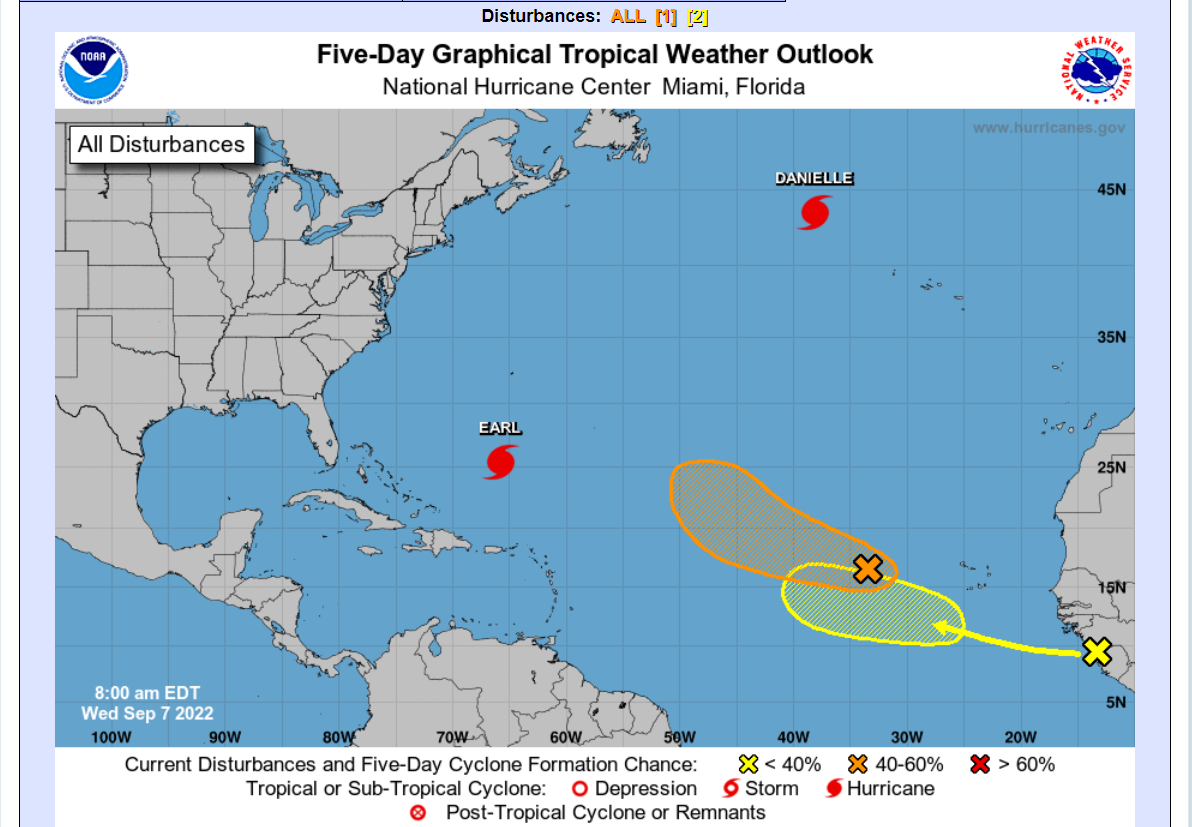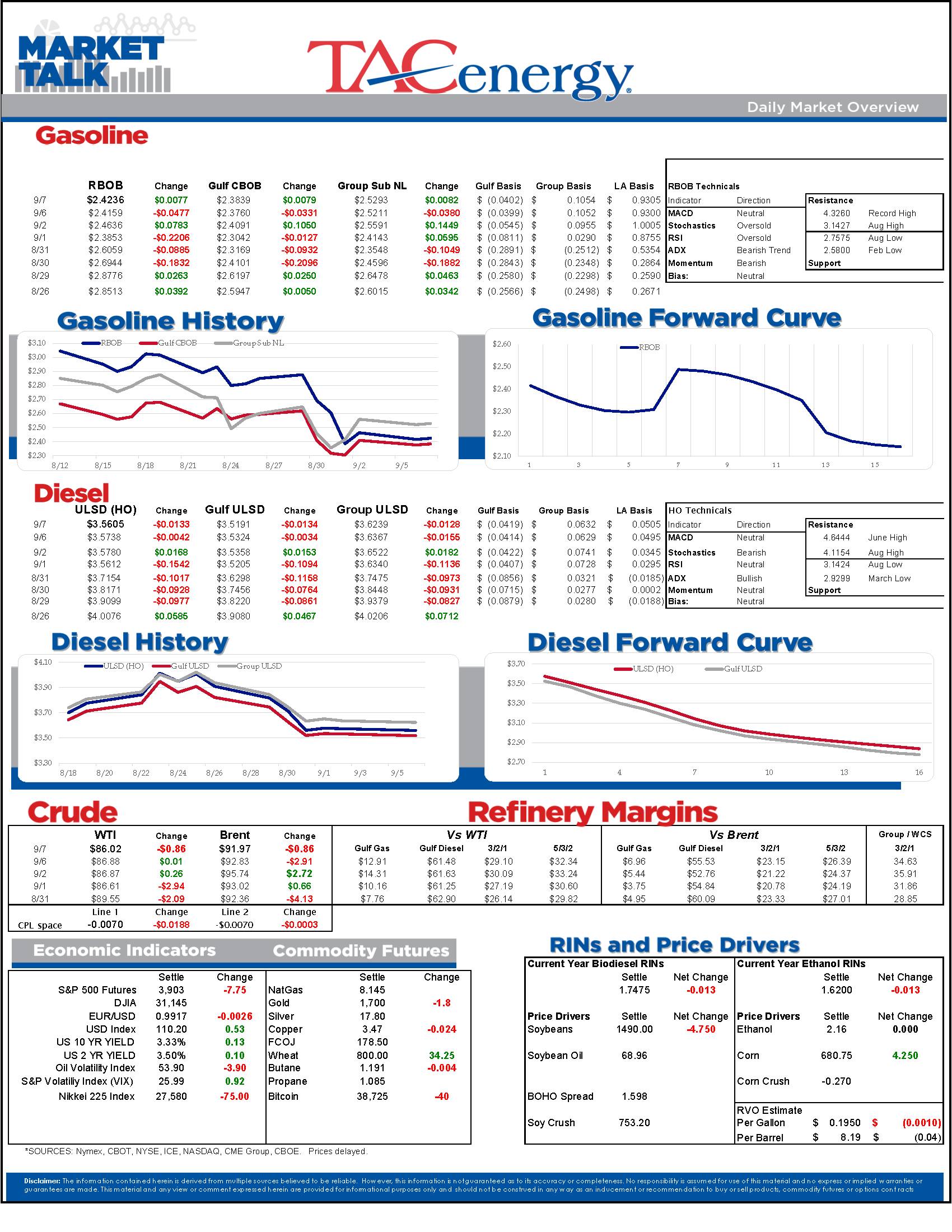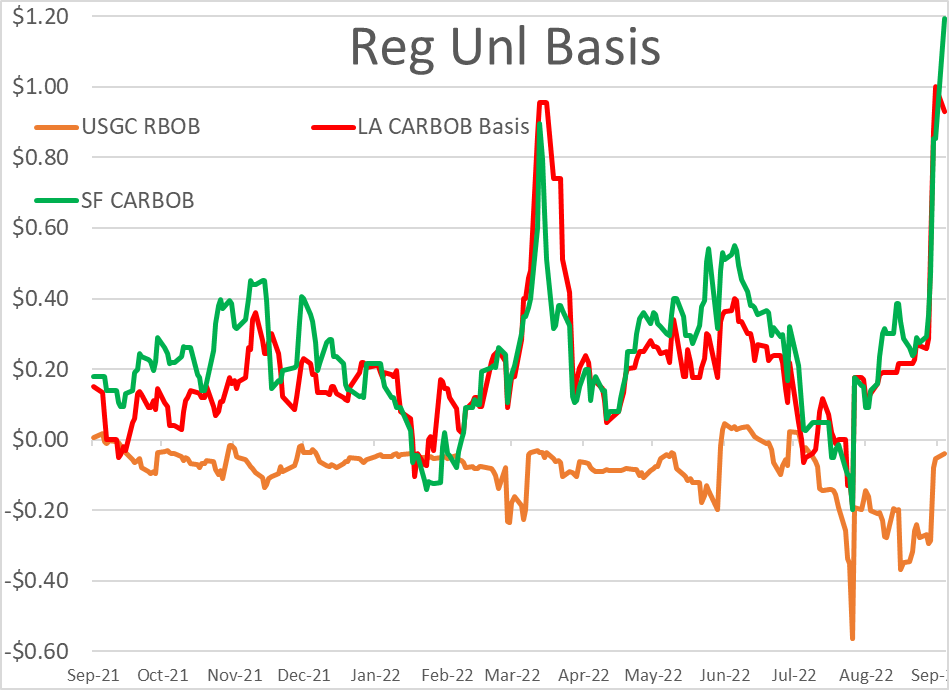After A Big Labor Day Rally, Diesel Prices Dropped 20 Cents From Monday’s Highs

Volatile price movement on low volume has become a major theme in energy markets as traders seen to be vacillating between supply fears and demand fears daily.
After a big Labor Day rally, Diesel prices dropped 20 cents from Monday’s highs, ending Tuesday’s session down slightly from Friday’s settlement. That brief rally managed to close the chart gap left behind by the September contract roll, and the subsequent selloff sets up a test of last week’s low at $3.44.
Gasoline futures are down for the week, despite a modest bounce this morning, and the charts continue to suggest a good chance that we’ll see more selling in the weeks ahead. Crumbling values for NYH spot prices seem to be adding to the weak sentiment for futures, and driving the value for linespace on Colonial’s mainline to negative figures, just a week after they were trading for a 10 cent/gallon premium. While futures are looking weak, California gasoline prices continue to surge, trading $1.20/gallon over futures in LA Tuesday, as power concerns and refinery hiccups continue to hamper regional supplies. We will see a huge drop in those prices as we reach the transition to winter-spec gasoline, but that’s still 6 weeks away for California, whereas most of the rest of the country will change over next week.
European leaders are planning to enact a price cap on Russian energy supplies to try and curb runaway electricity prices, and Russia’s countermove is to threaten a complete shutdown of energy exports if those caps are enacted.
China’s oil imports dropped 9% in August vs a year ago, and with more cities enforcing lockdowns in September, the demand from the world’s largest buyer is set to drop even further.
The huge spike in European electricity prices following Russia’s moves to cut off natural gas flows to the continent have left utilities in need of more than $1.5 trillion to meet margin calls, which could force some companies out of business and more to stop trading. We’ve seen a similar although so far less extreme example of this in the ULSD contract as the incredible volatility this spring drove a huge decline in open interest, and volume traded, which is adding to the volatility we’re experiencing now.
The weekly inventory reports are delayed a day due to the holiday, so expect the API report this afternoon and the DOE’s report tomorrow morning.
The EIA Tuesday highlighted 3 new LNG export projects scheduled in the US, that would increase capacity by nearly 1/3. That’s the good news. The bad news for parts of the world in desperate need of more natural gas supply is those projects don’t start for another year, and aren’t scheduled to be online until 2026.
There are two hurricanes in the Atlantic, and one in the Pacific today, but none of these storms appears to be a threat to energy infrastructure, even though Hurricane Kay is bringing rare tropical storm warnings to parts of Southern California. Kay looks like it could be a double-edged sword for the state, as it may snap the heat wave that’s brought the state’s electric grid to the brink of failure, but will bring high winds and rain to the area that could cause problems of their own. There are two more potential systems being tracked by the NHC, but the early guesses suggest low odds that either one will be a threat to the US.
Click here to download a PDF of today's TACenergy Market Talk.
News & Views
View All
Week 18 - US DOE Inventory Recap

Crude Oil, Gasoline, And Diesel Benchmarks Are All Trading >1% Lower To Start The Day
Energy prices are sinking again this morning, albeit with a little more conviction than yesterday’s lackadaisical wilting. Crude oil, gasoline, and diesel benchmarks are all trading >1% lower to start the day with headlines pointing to an across-the-board build in national inventories as the source for this morning’s bearish sentiment. The Department of Energy’s official report is due out at its regular time this morning (9:30am CDT).
WTI has broken below its 100-day moving average this morning as it fleshed out the downward trend that began early last month. While crossing this technical threshold may not be significant in and of itself (it happened multiple times back in February), the fact that it coincides with the weekly and monthly charts also breaking below a handful of their respective moving averages paints a pretty bearish picture in the short term. The door is open for prices to drop down to $75 per barrel in the next couple weeks.
Shortly after the EIA’s weekly data showed U.S. commercial crude inventories surpassing 2023 levels for the first time this year, their monthly short-term energy outlook is forecasting a fall back to the bottom end of the 5-year range by August due to increasing refinery runs over the period. However, afterward the administration expects a rise in inventories into 2025, citing continued production increases and loosening global markets hindering the incentive to send those excess barrels overseas. The agency also cut back their average gas and diesel price forecasts for the first time since February with the biggest reductions in the second and third quarter of this year.
The STEO also featured their famed price prediction for WTI, stating with 95% confidence that the price for crude oil will be between $40 and $140 through 2026.
Need a general indication of the global crude oil supply? Most headlines seem to be covering a shortage of a different type of oil, one that we haven’t turned into fuel (yet).
Click here to download a PDF of today's TACenergy Market Talk.

The Perceived Cooling Of Regional Tensions In The Middle East Area Attributing To The Quiet Start To Today’s Trading Session
The energy complex is drifting lower this morning with RBOB futures outpacing its counterparts, trading -.9% lower so far to start the day. The oils (WTI, Brent, heating) are down only .2%-.3% so far this morning.
The perceived cooling of regional tensions in the Middle East area attributing to the quiet start to today’s trading session, despite Israel’s seizure of an important border crossing. A ceasefire/hostage-release agreement was proposed Monday, and accepted by Hamas, but rejected by Israel as they seemingly pushed ahead with their Rafah offensive.
U.S. oil and natural gas production both hit record highs in 2023 and continue to rise in 2024, with oil output currently standing at 13.12 million barrels per day and January 2024 natural gas production slightly exceeding the previous year. With WTI currently changing hands at higher than year-ago levels, this increased production trend is expected to continue despite a decrease in rigs drilling for these resources.
Less than a week after the Senate Budget Committee’s hearing centered on the credibility of big oil’s climate preservation efforts, a major oil company was reported to have sold millions of carbon capture credits, without capturing any carbon. Fraud surrounding government subsidies to push climate-conscious fuel initiatives is nothing new, on a small scale, but it will be interesting to see how much (if any) of the book is thrown at a major refiner.
Today’s interesting read: sourcing hydrogen for refining.
Click here to download a PDF of today's TACenergy Market Talk.



